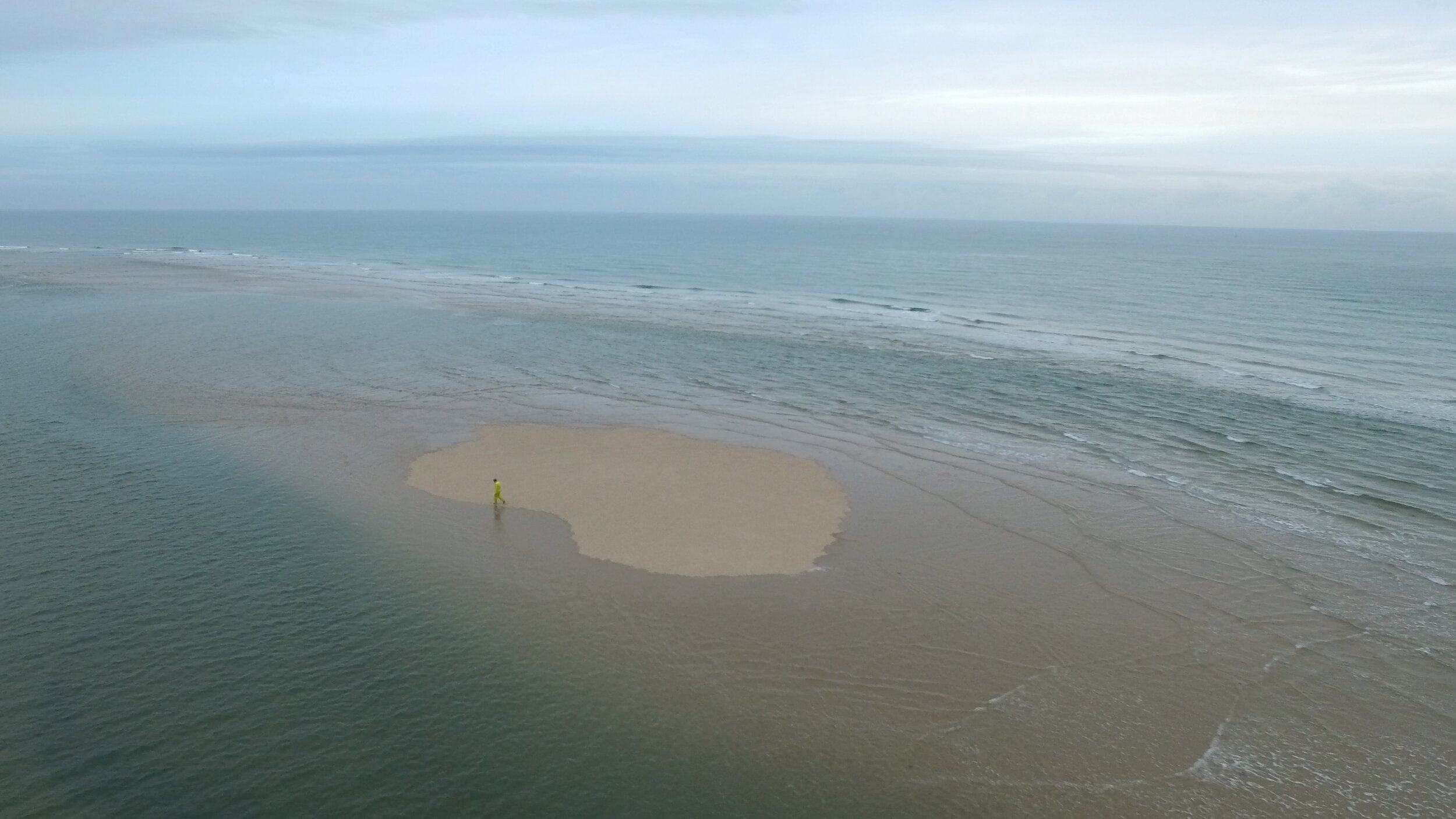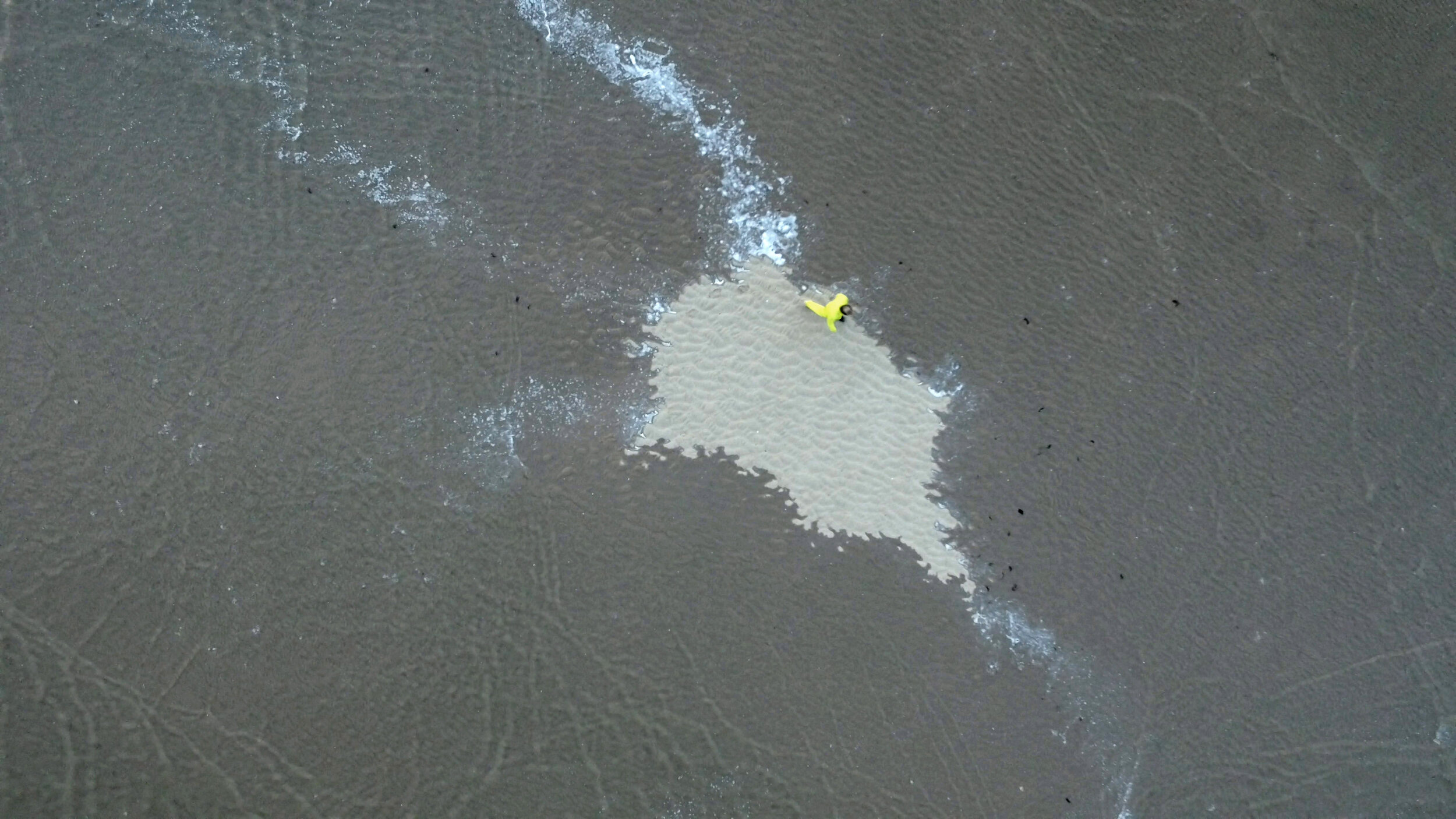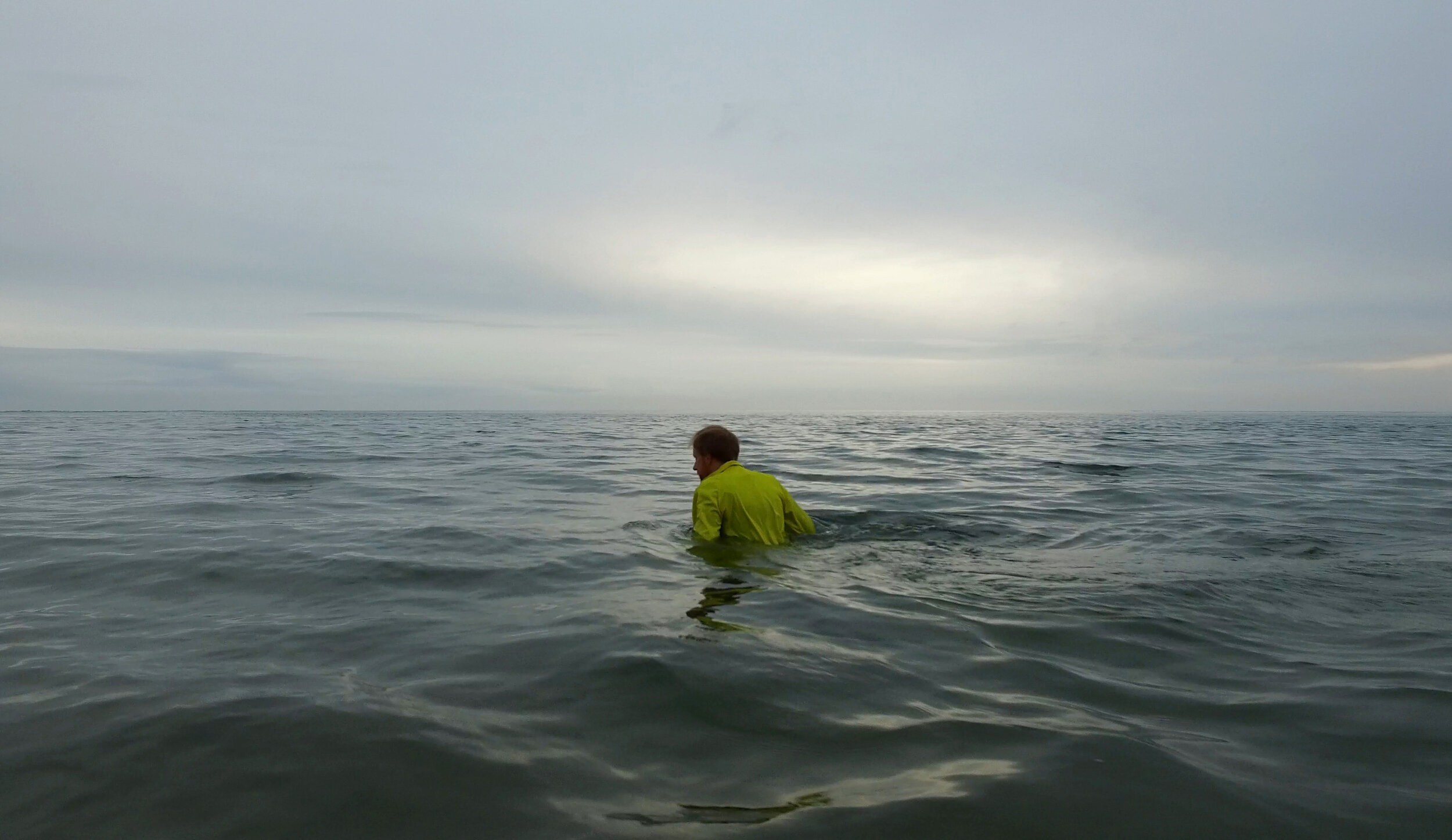Simon Faithfull: Interviewed by Rebecca Partridge

Simon Faithfull’s three decade long career has seen him traversing the planet, ‘testing the limits of the world and reporting back from its extremities’. He has followed the Greenwich meridian across Europe and Africa, sent a chair into Earth’s stratosphere, walked through a burning jet plane and sunk a ship off the south coast to create an artificial reef, all the while recording more quotidian life in his ever-expanding archive of digital drawings. Faithfull’s work challenges us to think of the planet as a sculptural object and consider our scale within that. Between London and Berlin we met up in the digital ether to discuss his practice and what it means to engage with landscape as our relationship to it undergoes dramatic change.
“...I take Earth magnitude to mean “at a scale sufficient to open the concept Earth to full amplitude”. Solar winds do this as they interact with Earth’s magnetic shield and produce Auroras. Global climate does this: the mass of terrestrial weather events are downwardly caused by a massive entity that exists at Earth magnitude. Human thought at Earth magnitude is human thinking that is as “large” as the aurora. It can think the aurora in such a way that its vastness is witnessed and opened in us. A single person can do this on the ground. You don’t need to be a geostationary satellite or a scientist or an astronaut. Or a member of UN or CEO of global corporation.”
Rebecca Partridge: Let’s start with this quote from Timothy Morton, which you have identified as articulating broad ideas in your own work and also brings to mind Aurora Borealis (Unseen) (2008): the two-screen video work which you made in the Arctic Circle, one circular screen shows the image of your eye, looking, and the other an Aurora display – though you never did see the Aurora yourself?
Simon Faithfull: Exactly. I went with the intention of making a video-work using the aurora. I wanted to capture the Northern Lights reflected in my iris. What it ended up being was the forest and the science station captured within my eye, but never actually seeing the aurora. So it’s like a failed quest. But the scientists at the Aurora Research Station in the very north of Finland had this big radio telescope dish. Every night when it clouded over (and I couldn’t see anything) the dish was successfully seeing these incredible magnetic storms with green and red Aurora – which is what you see on the second screen. The Timothy Morton quote really struck me for this idea of sensing earth-scale phenomena. A single person trying to sense the scale of this rock that we are standing on, that is spinning in the black desert of space. What I try to do in my practice is to deal with something very immediate in front of me, but to extrapolate out and expand the frame of reference to an Earth-scale magnitude. So this ‘opened in us’, that’s sort of what I try to do within my work – for myself but also expanding other people’s consciousness to think at that magnitude.
Still from: 'Aurora Borealis (Unseen)' | 2 screen HD Video, 5min, 2008
RP Your practice has been described as ‘testing the limits of the world and reporting back from its extremities’. The idea of trying to get to an extremity or to find something expanded in yourself by doing so is born of Romanticism isn’t it really, wanting to look outward and transcend yourself through the experience of nature, or a kind of emptiness in landscape?
SF Historically such Romantic ideas are very problematic because it’s inevitably linked with exploring – where the empty wilderness is entwined with ideas of Empire and colony. Australia was deemed ‘Terra Nullis’, which is a legal justification for the claiming of that land because it is seen as ‘empty’, because ‘nobody’ is in it. Not that the romantic view of the wilderness necessarily leads to exploiting that land and claiming it, but the two are intertwined. I think behind the romantic viewpoint is something deeper which comes from awe and wonder… looking up at the stars at night and being expanded from the minutiae of your life into some incredible cosmic scale. So, yes, personally, I definitely find some kind of sustenance in emptiness.
RP Romanticism has also been problematic in recent cultural history because of the associations with sentimentality or emotionality. Yet now, interestingly, there appears to be space opening up for wonder, as you say, and imagination. That feeling of smallness and vastness as we look up at the stars is timeless, but we are perhaps finding a new – less sentimental – language for it, it is about the terminology.
SF I think it’s really interesting. I gave a talk recently, discussing land artists both American and British, where I drew a line from Caspar David Friedrich to Richard Long. Long in a way attempts to distance himself from anything to do with romance through the language of minimalism – it appears dry and conceptual. In the early work he avoids picturing a vast landscape, and yet it’s deeply romantic work. It’s exactly the same as Caspar David Friedrich’s Wanderer Above a Sea of Fog. It’s one guy (and a white guy) wandering in a landscape, and so it’s exactly the same kind of romantic intention, a romantic voyage.
RP Yes there are many conceptual artists who seem very minimal and cool but who are actually dealing with romantic ideas. One of the most interesting things I find about Land Art (related to those conceptual or minimalist strategies) is that, when those artists left the studio to go out into the landscape they found a completely new language for making artworks – which liberated them to deal with timeless themes that were exhausted in other mediums and would have seemed clichéd, sentimental and uninteresting.
SF Absolutely. My solution to the Romanticism issue is not to say that I am romantic but that I am a sort of ‘wonder junkie’, to borrow a phrase from Carl Sagan. It describes for me probably what Richard Long is also doing and why he is scared of Romanticism but he can’t stop being a ‘wonder junkie’ and his work articulates that. I think ‘wonder’ about this lump of rock that is Earth, is part of a necessary awakening and that’s why ‘wonder junkies’ are really important.
RP I love that phrase. The other side of Romanticism which is interesting in relation to Timothy Morton, is the Anthropocene – which Morton describes in Ecology beyond Nature as beginning at the time of the industrial revolution and subsequent carbon emissions – historically parallel with the Romantic Movement. The motif of Romanticism that I’m thinking of in relation to this is that of decay and entropy – something that comes up in your work – the idea that, ultimately, nature wins. But yet, the beginning of the Anthropocene marks the moment when what was actually happening was that humans were becoming more powerful than nature, in a sense, and that ever since our imprint is shaping nature through our exploitation of it. So Romanticism is really complex because it’s not just cultural, or political, it’s now also an environmental and ecological issue, would you agree?
SF I think you’re right, and Romanticism coming about at the same time as the Industrial Revolution is I’m sure, linked. Marx talks about the worker becoming alienated from their creativity as they moved from the land to the factory. So, it’s no wonder that exactly when we lose connection to being embedded within the planet, we start to fetishize the planet that we’ve lost – which is maybe what the ‘Wanderer’ is doing? The 70s environmental awakening was brought about by seeing the planet in space, particularly Earthrise the famous image from Apollo where you see this blue marble floating in the blackness of space. So, yes, in a way, artists like Holt and Smithson were trying to get out of the city and reconnect with the landscape as a reaction against consumerism and capitalism. I think a lot of that awakening went back to sleep, but is certainly dramatically resurfacing now. But the 70s were also full of this feeling that Homo sapiens were surpassing nature, leaving it behind and that we’d be living on the moon or in bubbles under the ocean. So the realization of climate change and the biodiversity crisis came all of a sudden. That we are thoroughly embedded in a completely interdependent system of trillions of species that you cannot extricate yourself from. You can’t have successful Homo sapiens that are transcending nature, we’re all enmeshed in this symbiotic planetary system. That’s what the Anthropocene is revealing to us, that if you go way into the future in geological time and you look back, there will be a thin layer within the strata of the rock, which is the Anthropocene. That’s us. How thin that layer is that is being recorded in those rocks depends on us right now… it might be extremely thin, because in geological time 300 years is a blink of an eye. But, yeah. Who knows where it’s heading.
RP So whereas we must exist symbiotically with the planet, the planet doesn’t rely on us… it can adapt and recover. There are works that you’ve made, the REEF project for instance where you sank an old ship off the south coast but in doing so created the environment for a new ecosystem, new life, does this indicate a kind of optimism?
'REEF' | HD video, 9min, 2014
SF With REEF I was taking something from our time system – a working boat – which I sent on one last journey, 25 metres below the surface of the sea. Leaving our scales of time and entering geological time. By sinking a lump of something that you’ve prepared so it’s not toxic, it creates a surface that allows plants to attach to it, and this slowly becomes a reef. Often the sea floor can be a barren place but as soon as there’s something for plants to attach to then a whole ecosystem grows up, over hundreds or thousands of years. In 2005 I went to the Antarctic and I happened to be able to go to Stromness, a ghost-town where Shackleton reached salvation after his boat had been crushed in the ice. I made a video-work there of a whaling station taken over by seals that are living deep within the buildings; shitting, howling, breaking furniture… It felt like the world after we’ve gone, but instead of Planet of the Apes a planet of the seals. The idea with REEF was to do something similar with the bottom of the ocean: to take something from our world, and watch at least the beginning of a process, something leaving our time structure and entering geological time, inhabited by a whole new set of species. That is both positive and fatalistic, it recognises that species evolve and disappear the whole time and there’s nothing special about this monkey that started organising itself into large groups. So from a planetary point of view, yes the planet can adapt and evolve, it’s going through a massive extinction event but life on the planet is not threatened as an entity. Extinction Rebellion is titled very accurately, because, whereas the 70s idea was that morally we have to “save the planet” really it’s to do with whether we want to remain part of the story of this planet.
RP It’s hard to avoid the question of how environmentalism is often projected on to art works in a way that simplifies or co-opts their readings. How do you respond to this?
SF There’s a way that art can speak about things through the poetic, through fictions and dreamlike images, I think the power of art is that ‘fictioning’. There’s a book by David Burrows called Fictioning, which talks about the importance of fiction and stories: how artists embed things in a deeper level of consciousness. That’s what artists do really well. But this thing that art does really well doesn’t work when it’s a linear polemic or a kind of didactic crusade. I rather set out to try to understand the world and raise our awareness – from a blinkered, momentary or physically locked position, out to that kind of Earth scale consciousness.
Three stills from: 'Going Nowhere 1.5' | HD video (silent), 9min, 2016
RP I’m thinking about Going Nowhere 1.5 which was shot from a drone over a sand island in the North Sea that is slowly receding as the tide comes in. We see you from above walking the ever shrinking perimeter – until finally it disappears. We could read the rising sea level as an environmental comment but there are much more complex references; not only to Land Art and Smithson’s spiral jetty but again to those classic Romantic motifs. I see you as taking Caspar David Friedrich’s Monk by The Sea to its literal extremity in the act of actually immersing yourself in the sea. It’s not only a beautiful act but a ridiculous one, so there’s a simultaneous gravity and absurdity to the work.
SF A lot of my work ends up being imbued with this melancholic humour, the absurd Homo sapien predicament. I think that comes out of Buster Keaton… it’s like the cosmic joke of our existence that we are constantly trying to build things up and the universe is pulling them down. We have fantasies of omnipotence and we’re periodically slapped in the face and reminded of our own insignificance.
RP Many of your works have involved travelling great distances and now we can’t travel. How has that affected the work that you may be thinking about making now?
SF There is a side to my more recent work of going on quite epic journeys, like travelling by containership or going to Antarctica. But there’s another side which is about the total opposite, the sort of small mundane minutiae of everyday life. I think one of the first travelling works was Lea Navigation, where I cycled from the mouth of the river Lea in London to find its source beneath a tower block in Luton, but, whilst I was doing it, I had in mind Joseph Conrad travelling up the Congo, so there was a mental extrapolation to a larger scale. And more recently, I made a work called Voyages Within 100m of my Bed, which was just collecting together all the drawings I’ve made within that 100m radius. It’s about how the ‘at Earth scale’ is activated within our heads, that doesn’t mean that you necessarily need to travel. Everybody is reinventing their lives in this kind of awakening period that we’re living through, so how my practice is going to find its feet in this new world that is appearing all around us, is a very good question.
I think we’re really lucky being artists because we are good at finding ways to exist in this new kind of unfolding world – and to find ways to report back on how it tastes or feels.
Above: 'Voyages Within 100 Metres of my Bed', 91 digital drawings, 2017 | Below: 'Drawing #612: Me', digital drawing, 2010
Thank you – Simon Faithfull, currently living in Berlin, whose exhibition Memories from the Future has just finished in Galerie Polaris, Paris; and Rebecca Partridge, based in London, who recently presented the solo exhibition Painting Fast, Painting Slow in Konstraft Ljusne, Sweden.
All images above © Simon Faithfull | Text from Rebecca Partridge & Simon Faithfull for A La Luz | Please do not re-publish any of the above without prior written consent












